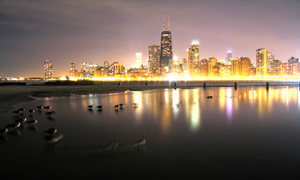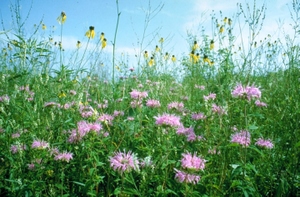Ecosystem Restoration Introduction
Introduction
 |
|
Photo by CMAP Photography Contest participant, Rex Flodstrom |
Beneath the complexity of our cities and towns many natural systems are constantly working to provide essential functions and elements that support life on Earth. Although these systems have been in place for billions of years, they are often seen as separate and distant, when in fact they are more closely intertwined in our everyday life—from the goods we buy to the air we breathe. The term "ecosystem" defines the complex interactions between these natural systems (geology, topography, climate and living things) in a defined geographic area (Sullivan, 2003). Ecosystems vary in both size and complexity but are usually referred to in larger functional units such as forests, wetlands, lakes, streams or watersheds (USEPA, 2008). The extremely integrated and symbiotic relationships in an ecosystem are the key to its survival and growth whereas even the displacement, absence or new presence of one species can alter an entire ecosystem (Sullivan, 2003).
As humans we are an integral part of every ecosystem either directly or indirectly through our actions. Although we represent one species among millions, our effects on ecosystems are comparably exponential (USEPA, 2008). Restoration is one way humans can positively influence the natural environment. Ecosystem restoration is an intentional activity that initiates or accelerates the recovery of an ecosystem that has been degraded, damaged, or destroyed yielding a site that "more closely emulates conditions which prevailed before disruption of natural structures and processes" (SERI, 2004)(Covington et al.). In most cases, this would resemble a historic stable and functioning ecosystem with a diversity of plants and animals with minimal required maintenance (Illinois State Museum Society). Restorative strategies include removing or modifying the disturbance(s), reintroducing native species and eliminating invasive species (SER, 2007). Invasive species are defined as non-native species that have uncontrolled growth in a new environment (INHS, 2001). However, ecosystem restoration is not just a straightforward list of tasks to be completed but a multifaceted process involving balancing delicate biological systems and human interaction specific to a region and its varying communities (Covington et al.).
 |
|
Bergamot in bloom, Forest Preserve District of DuPage County |
Illinois, once well known as "The Prairie State" is fortunate to have a history of abundant and varying grasslands, woodlands and wetlands. Over 350 different species of plants grew on the prairies of Illinois, Indiana, and Wisconsin during the pre-settlement era (Sullivan, 2003). Additionally, this 3-state region has almost a dozen different types of wooded communities as well as a variety of wetlands including marshes, fens, bogs and swamps. Each landscape has a unique combination of plants and animals and thus unique challenges when implementing ecosystem restoration (Sullivan, 2003). This diversity of landscapes supports a diversity of genes, species, and ecosystems in our region, which is commonly described as biodiversity (Chicago Region Biodiversity Council, 1999). This region's unique biodiversity can be linked back to the beginning of the Wisconsin glacial period (~70,000 years ago) that created the Lake Michigan shoreline (Sullivan, 2003). The deposits and materials left behind by the receding glaciers formed the raw material for our soil and landscapes (Sullivan, 2003). This developing environment was nurtured by Native American tribes such as the Illini, Miami, Dakota, Shawnee, Chickasaw, and Ho-Chunk that inhabited the land (Native Languages of the Americas). Over time a healthy regional ecosystem came to fruition with a variety of communities that serve as habitats to the region's plants and animals as well as provide an ecological setting for the spaces in which we work and live. The table below describes these communities in more detail.
Table 1: Living Communities in the Chicago Wilderness Ecosystem
Source: An Atlas of Biodiversity (Sullivan, 2003)
|
Living Communities |
Characteristics |
|
Dominant plants are grasses and develop on flat lands; fire dependent communities. |
|
A variety of natural communities with variation in tree coverage based on climate and soil moisture (wet, mesic, or dry). |
|
Type of wooded community; grasslands with some trees found in dry climate. |
|
Type of wooded community with the most commonly found trees being of the oak family and typical of mesic soils. |
|
Type of wooded community with density of trees in both mesic and wet soils. |
|
Type of wooded community in wet soil in or around floodplain area. |
|
Mountains of sands which sit above glacial drift; formed through sand blown by westerly winds and near shore currents in Lake Michigan. |
|
A diverse combination of vegetation, marsh, river, floodplain swamp, plants, sand and gravel etc. that vary in level of water coverage. |
|
Type of wetland with a variation of vegetation, and shallow water. |
|
Type of wetland that form in cold, acidic, low oxygen waters; contain plant life. |
|
Body of water large enough to have at least one wind-swept beach with ecologically complex communities. |
In our region, like much of the U.S., significant ecosystem degradation coincided with multiple landuse changes associated with European settlement. Unlike the Native Americans, Europeans were less equipped and less familiar with managing the land. Invasive species were introduced, significant changes in hydrology from urban and rural development were experienced, wetlands were drained for agriculture and land and water systems were mistreated by the introduction of a variety of pollutants (Chicago Region Biodiversity Council, 1999)(SER, 2007). Additionally in the past, naturally occurring and man-induced fires provided ecosystem renewal by controlling invasive species, adding nutrients to the soils and providing additional space for habitat growth (Illinois State Museum Society). Increased settlement promoted fire suppression causing significant disruption to these crucial renewal processes (Chicago Region Biodiversity Council, 1999). These above factors combined with naturally occurring events have compromised our region's ecosystems on various levels including some ecosystems that have completely lost the ability to repair themselves and perform essential functions such as stormwater management (Covington et al.). Today, ecosystem restoration is especially important given the developments and events that have unfolded in the past few centuries.
This paper briefly examines the benefits and challenges, the current status and the potential impacts of ecosystem restoration. The fifth section expands on the link between ecosystem restoration and climate change followed by the conclusion.